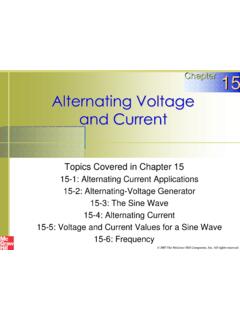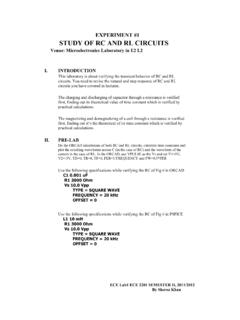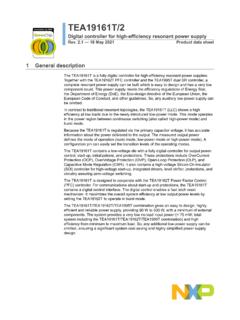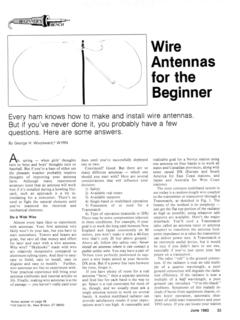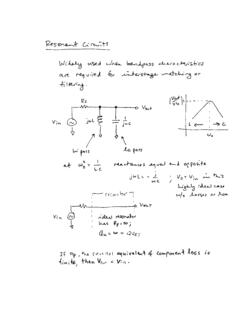Transcription of EXAMPLE PROBLEMS AND SOLUTIONS A-8-1. a is A-6-8.) of a s
1 Hence, we assume thc complete transfer function to be G(s)e-". Since the discrepancy hc tween the computed and experimental phasc angles is -C).?w rad for very high frequencies, we can determine the value of T as follows. ti Jim -- i'qjw)c-'"r = -I' z w-tn, dw 0 r T = sec. The presence of transport lag can thus be determined, and the complete transfer function deter- mined from the experimental curves is 330(x + 7)efi2' G'isje-" = .- s(s + I)(.s2 + f 64) EXAMPLE PROBLEMS AND SOLUTIONS A-8-1. Consider a system whose closed-loop transfer functmn is (This is the same system considered in Problem A-6-8.) Clearly, the closed-loop poles are locat- ed at s = -2 and s = -5, and the system is not oscillatory. (The unit-step response, however, ex- hibits overshoot due to the presence of a zero at s = -1. See Figure h-46.
2 Show that the closed-loop freq~uncy response of this systcm will exhibit a resonant peak. al- though the dumping ratio of the closed-loop poles is greater than unity. Solution. Qurc 8-92 shows the Bodc diagram for- the system. The resonant peak value is np- proximately dB. (Note that, in the abscnce of n zero. thc second-order system with [ ;- \\ill not exhibit a resonant peak; ho\vevcr, the presence of a closed-loop zero will cause such a peak.,) EXAMPLE PROBLEMS and SOLUTIONS A-8-2. Consider the system defined by Obtain the sinusoidal transfer functions Yl(jw)/Ul(jw), Y2(jw)/U,(jw), Y1(jw)/U2(jw), and &(jw)/U2(jw) In deriving Y,(jw)/U,(jw) and Y2(jw)/Ul(jw), we assume that U2(jo) = 0. Simi- larly, in obtaining Yl(jo)/U2(jw) and Y2(jo)/U2(jw), we assume that U, (jw) = 0. Solution. The transfer matrix expression for the system defined by x = Ax + Bu y = Cx + Du is given by Y(s) = G(s)U(s) where G(s) is the transfer matrix and is given by For the system considered here, the transfer matrix becomes Hence Assuming that U2(jw) = 0, we find Y,(jw)/U,(jw) and Y2(jw)/U,(jw) as follows: Similarly, assuming that U,(jw) = 0, we find YI(jw)/U2(jw) and Y2(jw)/U2(jw) as follows: YlGJ) - -- jw + 5 U2(jw) (j~)~ + 4jw + 25 y2(jw) - jw - 25 -- - 2) (j~)~ + 4jw + 25 Notice that Y,(jw)/U2(jw) is a nonminimum-phase transfer function.]
3 Chapter 8 / Frequency-Response Analysis A-8-3. Referring to Problem A-8-2, plot Bode diagrams for the system, usillg MATLAB Solution. MATLAB Program 8-14 produces Bode diagrams for the system. There are four sets of Bode diagrams: two for input 1 and two for input 2. These Bode diagrams are shown in Figure 8-93. MATLAB Program 8-1 4 A = [0 1 ;-25 -41; B=[l 1;o 11; c = [l 0;o 1 I; D = [O 0;o 01; bode(A,B,C,D) From: U, Bode D~agrams From: ti2 Figure 8-93 Bode diagrxns EXAMPLE PROBLEMS and SOLUTIONS Figure 8-94 Closed-loop system. A-8-4. Using MATLAB, plot Bode diagrams for the closed-loop system shown in Figure 8-94 for K = 1, K = 10, and K = 20. Plot three magnitude curves in one diagram and three phase-angle curves in another diagram. Solution. The closed-loop transfer function of the system is given by C(s) -- - K R(s) s(s + l)(s + 5) + K - - K s3 + 6s' + 5s + K Hence the numerator and denominator of C(s)/R(s) are num=[O 0 0 K] den = 11 6 5 K] A possible MATLAB program is shown in MATLAB Program resulting Bode diagrams are shown in Figures 8-%(a) and (b).]]]
4 MATLAB Program 8-1 5 --- w = logspace(-1,2,200); for i = 1 :3; if i = 1; K = l;[mag,phase,wl = bode(I0 0 0 K1,[1 6 5 K1,w); mag1 dB = 20*log1 O(mag); phase1 = phase; end; if i = 2; K = 1 O;[mag,phase,w] = bode([O 0 0 K], [I 6 5 K],w); mag2dB = 20*log1 O(mag); phase2 = phase; end; if i = 3; K = 20;[mag,phase,w] = bode([O 0 0 K],[1 6 5 K],w); mag3dB = 20*log1 0(mag); phase3 = phase; end; end semilogx(w,magl dB,'-',wImag2dB,'-',w,mag3dB,'-') grid title('Bode Diagrams of G(s) = K/[s(s + 1 )(s + 5)], where K = 1, K = 10, and K = 20') xlabel('Frequency (rad/secI1) ylabel('Gain (dB)') text( ,-31 ,'K = 1 ') text(1 .l ,-8,'K = 10') text(l1,-31 ,'K = 20') semilogx(w,phasel ,'-',wIphase2, '-'I~Iphase3,'-') grid xlabel('Frequency (rad/secI1) ylabel('Phase (deg)') text( ,-90,'K = 1 ') text( ,-20,'K =lo') text( ,-20,'K = 20') Chapter 8 / Frequency-Response Analysis Figure 8-95 Bode diagra ns: (a) Magnitude- versus-frequzncy curves: (b) phase- angle-versus- frequency citrves.))]]
5 Frequency (radlscc) (2) A-8-5. Prove that the polar plot of the sinusoidal transfer function is a semicircle. Find the center and radius of the circle. EXAMPLE PROBLEMS and SOLUTIONS Solution. The given sinusoidal transfer function G(jo) can be written as follows: where Then Hence, we see that the plot of G(jw) is a circle centered at ( ,O) with radius equal to upper semicircle corresponds to 0 5 w 5 co, and the lower semicircle corresponds to -co 5 0 5 0. A-8-6. Prove the following mapping theorem: Let F(s) be a ratio of polynomials in s. Let P be the num- ber of poles and Z be the number of zeros of F(s) that lie inside a closed contour in the s plane, with multiplicity accounted for. Let the closed contour be such that it does not pass through any poles or zeros of F(s).The closed contour in the s plane then maps into the F(s) plane as a closed number N of clockwise encirclements of the origin of the F(s) plane, as a representa- tive points traces out the entire contour in the s plane in the clockwise direction, is equal to Z - P.
6 Solution. To prove this theorem, we use Cauchy's theorem and the residue theorem. Cauchy's theorem states that the integral of F(s) around a closed contour in the s plane is zero if F(s) is analytic within and on the closed contour. or Suppose that F(s) is given by where X(s) is analytic in the closed contour in the s plane and all the poles and zeros are located This may be seen from the following consideration: If F(s) is given by F(s) = (s + Z~)~X(S) then F(s) has a zero of kth order at s = -zl. Differentiating F(s) with respect to s yields F1(s) = k(s 4 z,)~-'x(s) + (S + z,)~x'(s) Hence, We see that by taking the ratio F1(s)/F(s), the kth-order zero of F(s) becomes a simple pole of F'(s)lF(s). Chapter 8 / Frequency-Response Analysis If the last term on the right-hand side of Equation (8-26) does not contain any poles or zeros in the closed contour in the s plane, Ff(s)/F(s) is analytic in this contour except at the zero s = -zi.
7 Then, referring to Equation (8-25) and using the residue theorem, which states that the integral of F'(.s)/F(s) taken in the clockwise direction around a closed contour in the .r plane is equal to -27i-j times the residues at the simple poles of F'(s)/F(s), or we have where Z = k, + h2 + .. - = total number of /eras of F(s) enclosed in the closed contour in the s plane P = rn, + In, + .. = total number of poles of F(s) enclosed in the closed contour in the s plane [The k multiple zeros (or poles) are considered k zeros (or poles) located at the same point.] Since F(s) is a complex quantity, F(s) can be written and Notins that Fr(~)/F(r) can be written we obtain If the closed contour in the .s plane is mapped into the closed contour r in the F(s) plane, then The integral $,.ri In(F1 is zero since the magnitude InJF/ 1s the same at the initial point and the final point of the contour 1: Thus we obtain The angular difference between the final and initial values of 0 is equal to the total change in the phase angle of Ff(s)/F(s) as a representative point in the s plane moves along the closed contour.)
8 Noting that N is the number of clockwise encirclements of the origin of the F(s) plane and B2 - 0, is zero or a multiple of 2n sad, we obtain EXAMPLE PROBLEMS and SOLUTIONS Figure 8-96 Determination of encirclement of the origin of F(s) plane. Figure 8-97 (a) Nyquist plot; (b) complete Nyquist plot in the G plane. '" t F(s) Plane "" t F(s) Plane Origin encircled 02-01=2r (a) Origin not encircled O2 - 0, = 0 ('J) Thus, we have the relationship This proves the theorem. Note that by this mapping theorem, the exact numbers of zeros and of poles cannot be found- only their difference. Note also that, from Figures 8-96(a) and (b), we see that if 0 does not change through 27r rad, then the origin of the F(s) plane cannot be encircled. The Nyquist plot (polar plot) of the open-loop frequency response of a unity-feedback control system is shown in Figure 8-97(a).
9 Assuming that the Nyquist path in the s plane encloses the entire right-half s plane, draw a complete Nyquist plot in the G answer the following questions: (a) If the open-loop transfer function has no poles in the right-half s plane, is the closed-loop system stable? (b) If the open-loop transfer function has one pole and no zeros in right-half s plane, is the closed- loop system stable? (c) If the open-loop transfer function has one zero and no poles in the right-half s plane, is the closed-loop system stable? (4 Chapter 8 / Frequency-Response Analysis Solution. Figure 8-97(b) shows a complete Nyquist plot in the G answers to the three questions are as follows: (a) The closed-loop system is stable, because the critical point (-I + j0) is not encircled by the Nyquist is,since P = O and N = O. we have Z = N + P = 0.)
10 (b) The open-loop transfer function has one pole in the right-half s plane. Hence, P = 1. (The open-loop system is unstable.) For the closed-loop system to be stable, the Nyquist plot must encircle the critical point (-1 + JO) once counterclockwise. However, the Nyquist plot does not encircle the critical point. Hence, N = , Z = N + P = closed-loop sys- tem is unstable. (c) Since the open-loop transfer function has one zero, but no poles, in the right-half s plane, we have Z = N + P = , the closed-loop system is stable. (Note that the zeros of the open-loop transfer function do not affect the stability of the closed-loop system.) A-8-8. Is a closed-loop system with the following open-loop transfer function and with K = 2 stable? Find the critical value of the gain K for stability. Solution. The open-loop transfer function is - K - -- -3w2 c jw(1 - 2w2) This open-loop transfer function has no poles in the right-half s plane.

